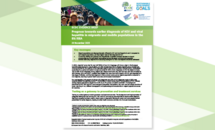Evidence brief: Progress towards earlier diagnosis of HIV and viral hepatitis in migrants and mobile populations in the EU/EEA
In 2023, migrants accounted for over half (56%) of new HIV diagnoses with known origin in the European Union/European Economic Area (EU/EEA), an 18% increase from 2014. People originating from sub-Saharan Africa accounted for the majority of the diagnosed cases in 2023 out of those born abroad (32%), while people originating from central and eastern Europe accounted for 30% of new diagnoses and for the largest increase. The number of HIV diagnoses among migrant gay, bisexual and other men who have sex with men increased by 38% between 2014 and 2023.
Available data suggest that more than half of people with HIV get diagnosed at a late stage of infection, and that late diagnosis is more common among some migrant populations compared to non-migrants, resulting in poorer health outcomes and increased transmission.
For viral hepatitis, 34% percent of all new HBV diagnoses and 23% of HCV diagnoses made in 2023 were acquired outside the reporting country. Furthermore, a recent review found that prevalence of HBV (HBsAg) among migrant populations ranged from 0.9% to 31.7% across 11 EU/EEA countries. The background prevalence of HIV, HBV and HCV and coverage of prevention interventions vary over time and across countries of origin, resulting in very different demographic and epidemiological characteristics in migrant populations across EU countries.








